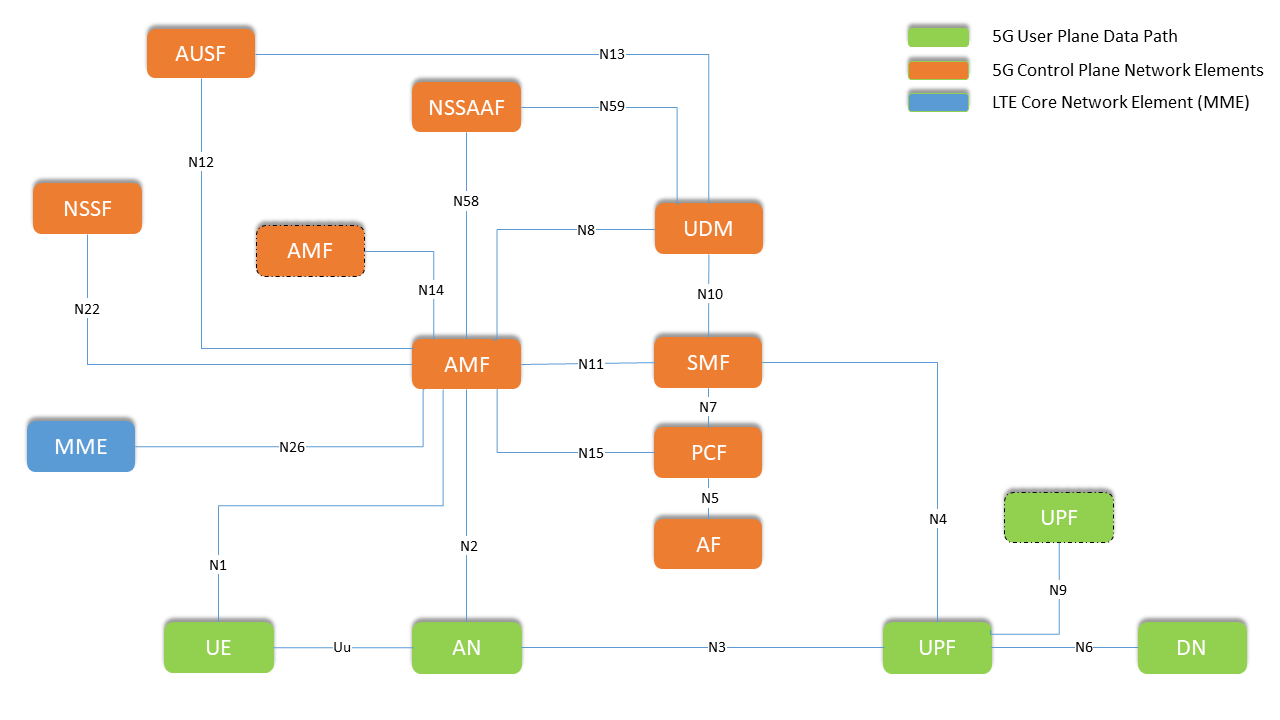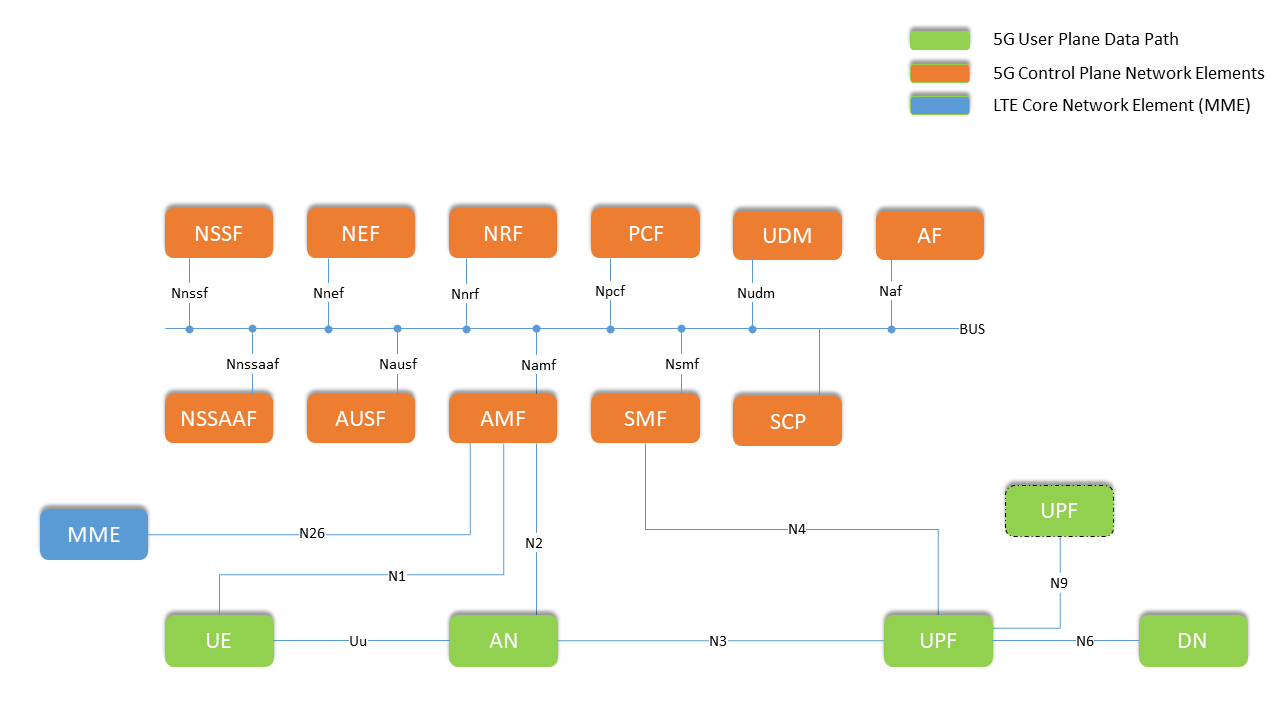We already paced to a new era with 5G which is completely different than legacy technologies. 5G is not only high data internet speed service provider, it covers a very large scale of areas such as logistic industry, transportation, entertainment, farming, planting and many others. But today we will not talk about delivered services by 5G, instead of that we will briefly present the heart of the technology which is 5GC or in other word 5G Core Network.
- Introduction
- 5G Core Architecture models
- List of Network Functions and entities.
- Interface Names in Reference Point Architecture
- Interface Names in Service Based Architecture
- Functionalities of Network Functions and entities
Introduction
Typical 5G system network architecture consists of Core Network, Access Network and User Equipment, this part is a bit like previous generations which we already have such domains.
The 5G System architecture is defined to support data connectivity and services enabling deployments to use techniques such as e.g. Network Function Virtualization and Software Defined Networking. The 5G System architecture shall leverage service-based interactions between Control Plane (CP) Network Functions where identified. Some key principles and concept are to:
- Separate the User Plane (UP) functions from the Control Plane (CP) functions, allowing independent scalability, evolution and flexible deployments e.g. centralized location or distributed (remote) location.
- Modularize the function design, e.g. to enable flexible and efficient network slicing.
- Enable each Network Function and its Network Function Services to interact with other NF and its Network Function Services directly or indirectly via a Service Communication Proxy if required.
- Minimize dependencies between the Access Network (AN) and the Core Network (CN). The architecture is defined with a converged core network with a common AN – CN interface which integrates different Access
5G Core Architecture models
3GPP specified and presents both versions of 5G system architectures:
- Reference Point System Architecture
- Service Based System Architecture
A reference point representation, shows the interaction exist between network elements by point-to-point reference point. It is like a point-point interface between two network elements e.g. N11 interface between AMF and SMF. In reference point system architecture, the interface names are labeled like: N5, N7, N8 etc.

A service-based representation, where network functions (e.g. AMF) within the Control Plane enables other authorized network functions to access their services. This representation also includes point-to-point reference points where necessary. In service-based system architecture each network functions are connected to a bus and connection labeled like: Namf, Nsmf, Nudm etc.

NFs and NF services can communicate directly, referred to as Direct Communication, or indirectly via the SCP, referred to as Indirect Communication. We will have SCP description below.
Network Functions and entities
The 5G System architecture consists of the following network functions (NF).
– Authentication Server Function (AUSF)
– Access and Mobility Management Function (AMF)
– Data Network (DN)
– Unstructured Data Storage Function (UDSF)
– Network Exposure Function (NEF)
– Network Repository Function (NRF)
– Network Slice Specific Authentication and Authorization Function (NSSAAF)
– Network Slice Selection Function (NSSF)
– Policy Control Function (PCF)
– Session Management Function (SMF)
– Unified Data Management (UDM)
– Unified Data Repository (UDR)
– User Plane Function (UPF)
– Application Function (AF)
– User Equipment (UE)
– (Radio) Access Network ((R)AN)
– 5G-Equipment Identity Register (5G-EIR)
– Network Data Analytics Function (NWDAF)
– CHarging Function (CHF)
– Service Communication Proxy (SCP)
Interface Names in Reference Point Architecture
The 5G System Architecture contains the following reference points:
N1: Reference point between the UE and the AMF.
N2: Reference point between the (R)AN and the AMF.
N3: Reference point between the (R)AN and the UPF.
N4: Reference point between the SMF and the UPF.
N6: Reference point between the UPF and a Data Network.
N9: Reference point between two UPFs.
N5: Reference point between the PCF and an AF.
N7: Reference point between the SMF and the PCF.
N8: Reference point between the UDM and the AMF.
N10: Reference point between the UDM and the SMF.
N11: Reference point between the AMF and the SMF.
N12: Reference point between AMF and AUSF.
N13: Reference point between the UDM and Authentication Server function the AUSF.
N14: Reference point between two AMFs.
N15: Reference point between the PCF and the AMF
N16: Reference point between two SMFs
N16a: Reference point between SMF and I-SMF.
N17: Reference point between AMF and 5G-EIR.
N18: Reference point between any NF and UDSF.
N19: Reference point between two PSA UPFs for 5G LAN-type service.
N22: Reference point between AMF and NSSF.
N23: Reference point between PCF and NWDAF.
N24: Reference point between the PCF in the visited network and the PCF in the home network.
N26: Reference point between AMF and MME
N27: Reference point between NRF in the visited network and the NRF in the home network.
N28: Reference point between PCF and CHF.
N29: Reference point between NEF and SMF.
N30: Reference point between PCF and NEF.
N31: Reference point between the NSSF in the visited network and the NSSF in the home network.
N32: Reference point between SEPP in the visited network and the SEPP in the home network.
N33: Reference point between NEF and AF.
N34: Reference point between NSSF and NWDAF.
N35: Reference point between UDM and UDR.
N36: Reference point between PCF and UDR.
N37: Reference point between NEF and UDR.
N38: Reference point between I-SMFs.
N40: Reference point between SMF and the CHF.
N50: Reference point between AMF and the CBCF.
N51: Reference point between AMF and NEF.
N52: Reference point between NEF and UDM.
N55: Reference point between AMF and the UCMF.
N56: Reference point between NEF and the UCMF.
N57: Reference point between AF and the UCMF.
N58: Reference point between AMF and the NSSAAF.
N59: Reference point between UDM and the NSSAAF.
NOTE: The reference points from N40 up to and including N49 are reserved for future usage
Interface Names in Service Based Architecture
Namf: Service-based interface exhibited by AMF.
Nsmf: Service-based interface exhibited by SMF.
Nnef: Service-based interface exhibited by NEF.
Npcf: Service-based interface exhibited by PCF.
Nudm: Service-based interface exhibited by UDM.
Naf: Service-based interface exhibited by AF.
Nnrf: Service-based interface exhibited by NRF.
Nnssaaf: Service-based interface exhibited by NSSAAF.
Nnssf: Service-based interface exhibited by NSSF.
Nausf: Service-based interface exhibited by AUSF.
Nudr: Service-based interface exhibited by UDR.
Nudsf: Service-based interface exhibited by UDSF.
N5g-eir: Service-based interface exhibited by 5G-EIR.
Nnwdaf: Service-based interface exhibited by NWDAF.
Nchf: Service-based interface exhibited by CHF.
Nucmf: Service-based interface exhibited by UCMF.
Responsibilities of Network Functions and entities
Authentication Server Function (AUSF) is responsible to handle authentication requests for both, 3GPP access and untrusted non-3GPP access.
Access and Mobility Management Function (AMF) has huge number of responsibilities, but below ones are some of them: Registration management, Connection management, Reachability management, Mobility Management, Access Authentication, Access Authorization.
Data Network (DN), e.g. operator services, Internet access or 3rd party services.
Unstructured Data Storage Function (UDSF) is introduced to store dynamic state data (e.g. UE-related data, context can be stored in a central UDSF and multiple AMF can reach this context anytime to handle the procedure for seamless continuation of services in case of serving AMF experience outage). Network functions may have their own UDSF or it can be common. Here structured data refers to data for which the structure is defined in 3GPP specifications and unstructured data refers to data for which the structure is not defined in 3GPP specifications.
Network Exposure Function (NEF) supports exposure of network functions capabilities in 5G system to external network functions such as 3rd party, Application Functions. External exposure can be categorized as Monitoring capability, Provisioning capability, Policy/Charging capability and Analytics reporting capability. The Monitoring capability is for monitoring of specific event for UE in 5G System and making such monitoring events information available for external exposure via the NEF. The Provisioning capability is for allowing external party to provision of information which can be used for the UE in 5G System. The Policy/Charging capability is for handling QoS and charging policy for the UE based on the request from external party. The Analytics reporting capability is for allowing an external party to fetch or subscribe/unsubscribe to analytics information generated by 5G System (e.g. roaming status of a specific UE is reported by UDM to NEF and the NEF will transfer it to the 3rd party network function). Also 3rd party applications might be untrusted and NEF can be required.
Network Repository Function (NRF) is used for service discovering of network functions or simply say it allows every network function to discover the service list offered by other network functions.
Network Slice Specific Authentication and Authorization Function (NSSAAF) supports Network Slice-Specific Authentication and Authorization with a AAA Server (AAA-S). If the AAA-S belongs to a third party, the NSSAAF may contact the AAA-S via a AAA proxy (AAA-P).
Network Slice Selection Function (NSSF) is a control plane function within 5G core network and supports below functions for network slicing:
– Selecting the set of Network Slice instances serving the UE;
– Determining the Allowed NSSAI and, if needed, the mapping to the Subscribed S-NSSAIs;
– Determining the Configured NSSAI and, if needed, the mapping to the Subscribed S-NSSAIs;
– Determining the AMF Set to be used to serve the UE, or, based on configuration, a list of candidate AMF(s), possibly by querying the NRF.
Policy Control Function (PCF) provides policy rules to Control Plane functions (e.g. AMF) to enforce them, accesses subscription information relevant for policy decisions in a Unified Data Repository (UDR).
Session Management Function (SMF) includes the following functionality:
– Session Management e.g. Session Establishment, modify and release, including tunnel maintain between UPF and AN node.
– UE IP address allocation & management.
– DHCPv4 (server and client) and DHCPv6 (server and client) functions.
– Downlink Data Notification.
– Support P-CSCF discovery for IMS services.
Unified Data Management (UDM) is a control plane function of 5G core network, it is similar HSS in 4G network. It has following functionalities: subscription management, SMS management, storage and management of SUPI for each subscriber in the 5G system. Here SUPI is “Each subscriber in the 5G System shall be allocated one 5G Subscription Permanent Identifier (SUPI) for use within the 3GPP system. The 5G System supports identification of subscriptions independently of identification of the user equipment. Each UE accessing the 5G System shall be assigned a Permanent Equipment Identifier (PEI)”.
Unified Data Repository (UDR) is another type of storage which stores data belongs to UDM, PCF or NEF and others. It can be dedicated for a network function (e.g. only for UDM) or can be shared between multiple network functions. UDR has following functions:
– Storage and retrieval of subscription data by the UDM.
– Storage and retrieval of policy data by the PCF.
– Storage and retrieval of structured data for exposure.
User Plane Function (UPF) is responsible for routing and forwarding user plane packets Access Node (gNB) and external data network. It handles downlink packet buffering and downlink data notification triggering. Anchor point for Intra-/Inter-RAT mobility when applicable.
Application Function (AF) is a control plane function within 5G core network, provides application services to the subscriber. Example it can be for video streaming service. If an AF is trusted it can interact directly with 5GC network functions or if it is 3rd party, then it should interact with an NEF.
Network Data Analytics Function (NWDAF) represents operator managed network analytics logical function. The NWDAF includes the following functionality:
– Support data collection from NFs and AFs;
– Support data collection from OAM;
– Support analytics information provisioning to NFs, AF.
CHarging Function (CHF) is not described in this page, you can find specifications in 3GPP TS 32.240.
Service Communication Proxy (SCP) has following functionalities:
– Message forwarding and routing to destination NF/NF service.
– Message forwarding and routing to a next hop SCP.
– Indirect Communication, let’s have a bit more information for this function.
NF services may communicate directly between NF Service consumers and NF Service Producers, or indirectly via an SCP.
In Direct Communication, the NF Service consumer performs discovery of the target NF Service producer by local configuration or via NRF. The NF Service consumer communicates with the target NF Service producer directly.
In Indirect Communication, the NF Service consumer communicates with the target NF Service producer via a SCP. The NF Service consumer may be configured to perform discovery of the target NF Service producer directly, or delegate the discovery of the target NF Service Producer to the SCP used for Indirect Communication. In the latter case, the SCP uses the parameters provided by NF Service consumer to perform discovery and/or selection of the target NF Service producer. The SCP address may be locally configured in NF Service consumer.

References: 3GPP 23.501, 3GPP 21.915
